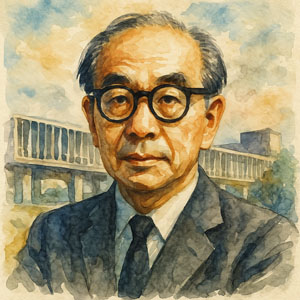— Kenzo Tange
 Born on this day in Imabari on Shikoku island, Japanese architect Kenzo Tange (1913–2005) has been called the “Father of 20th Century Japanese Architecture.”
Born on this day in Imabari on Shikoku island, Japanese architect Kenzo Tange (1913–2005) has been called the “Father of 20th Century Japanese Architecture.”
A student of Swiss modernist Le Corbusier, Tange led Japan’s reconstruction after World War II, helping spark the country’s rebirth and economic revival.
“It is very hard to be satisfied with past work,” he said. “I’ll only retire when I die.”
His 1949 Centre of Peace in Hiroshima symbolized resilience and a yearning for peace, launching him into international fame. His signature style blended Eastern simplicity with European elegance, rooted deeply in history while reaching toward the future.
Whether designing a museum, hotel, cathedral, or entire city plan, Tange’s versatile work always reflected evolving social needs. “I feel very fortunate to have witnessed the transformation of Japan from war-devastation to the affluence of today,” he said.
His 1964 Tokyo Olympic Games stadiums were hailed as “the most beautiful structures built in the twentieth century,” and in 1987, he received the Pritzker Architecture Prize, the highest honor in his field.
“Architecture must have something that appeals to the human heart,” he believed. “Creative work is expressed in our time as a union of technology and humanity.”
 The key to the future is blending technology with the heart.
The key to the future is blending technology with the heart.
